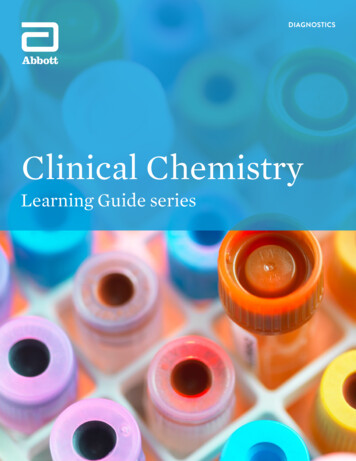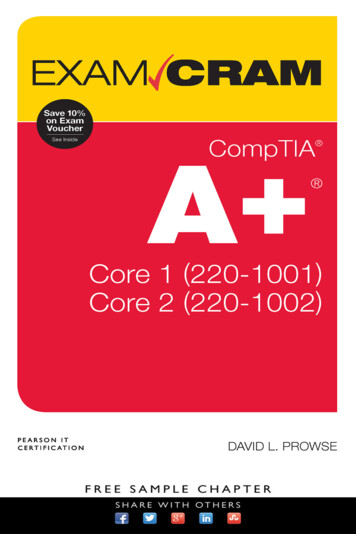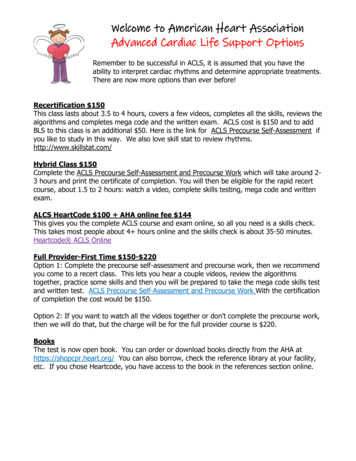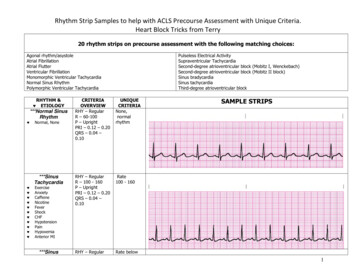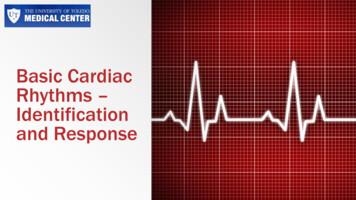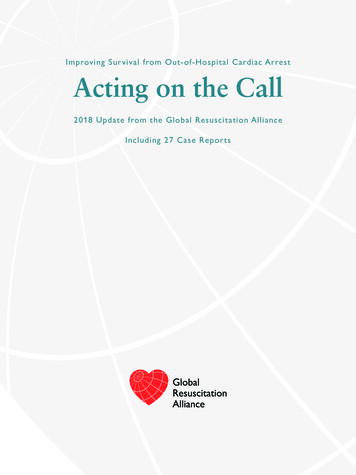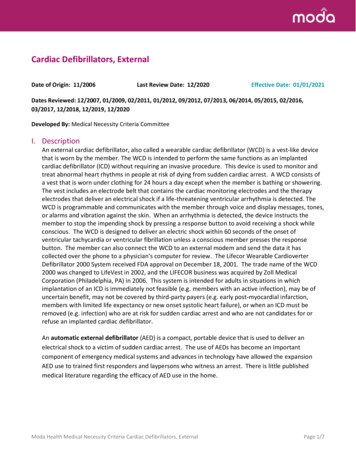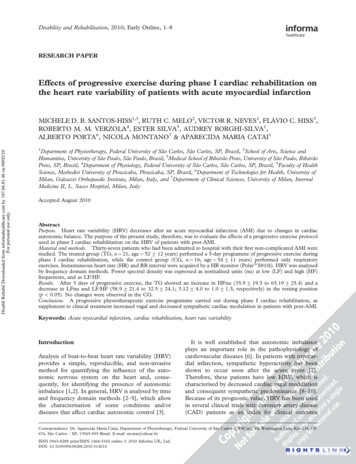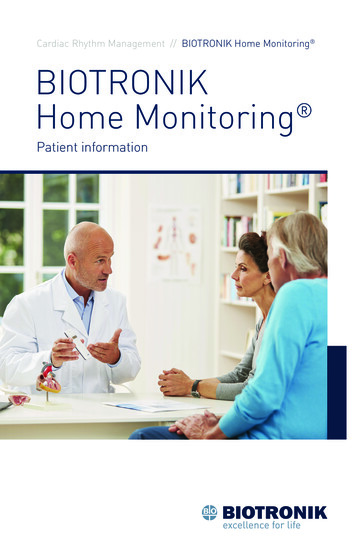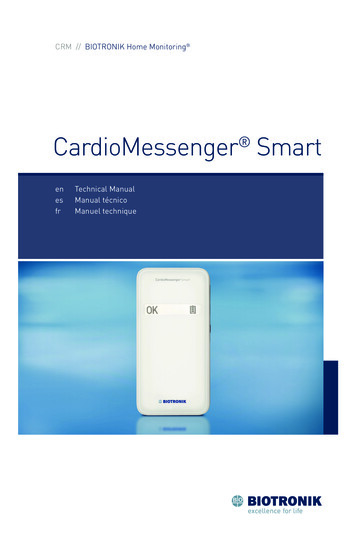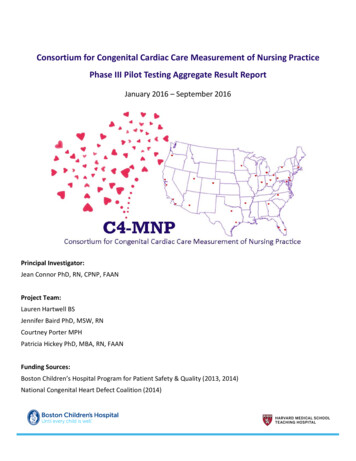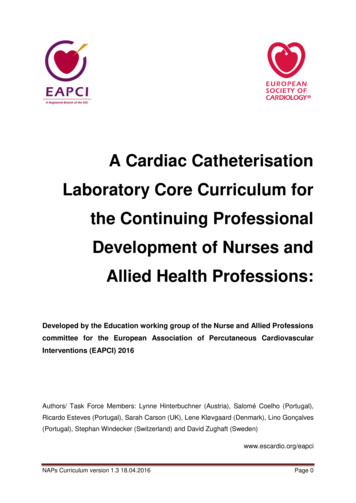
Transcription
A Cardiac CatheterisationLaboratory Core Curriculum forthe Continuing ProfessionalDevelopment of Nurses andAllied Health Professions:Developed by the Education working group of the Nurse and Allied Professionscommittee for the European Association of Percutaneous CardiovascularInterventions (EAPCI) 2016Authors/ Task Force Members: Lynne Hinterbuchner (Austria), Salomé Coelho (Portugal),Ricardo Esteves (Portugal), Sarah Carson (UK), Lene Kløvgaard (Denmark), Lino Gonçalves(Portugal), Stephan Windecker (Switzerland) and David Zughaft (Sweden)www.escardio.org/eapciNAPs Curriculum version 1.3 18.04.2016Page 0
Content1. Introduction . 22. Cardiac Cath Lab Curriculum Aims . 43. Development of the Core Curriculum for Cardiac Catheterisation LaboratoryNurses and Allied Professionals . 54. Structure. 54.1 Learning Objectives for the Specialty of Interventional Cardiology . 64.2 Levels of Experience and Time Frames for Education/ Training . 65. Assessment Methods . 96. Organization of the Training . 116.1 Entry Requirements . 116.2 Requirements for Training Centre . 116.3 Requirements for Local Trainers . 126.4 Adjunctive Training . 137. Cardiac Catheterisation Laboratory Curriculum Content . 138. Syllabus . 149. Core Curriculum Themes . 189.1 Theme 1- Fundamentals of Cardiovascular Pathophysiology . 199.2 Theme 2 - Fundamentals of Procedure & Technique. 219.3 Theme 3 - Fundamentals of Radiation & Imaging . 229.4 Theme 4 - Optimising Cardiovascular Risk Factors Control in the CathLab. 249.5 Theme 5 - Assessment, Planning and Managing Care in InterventionalCardiology . 269.6 Theme 6- Basic Understanding of Pharmacology & Appropriate Use ofMedications in the Cath Lab Setting . 289.7 Theme 7 - Principles and Practices of Person and Family centred Care &Emotional Care . 309.8 Theme 8 - Physical Well-being and Comfort . 329.9 Theme 9 - Evaluation of the Quality of Care and Research inInterventional Cardiology . 33References . 35NAPs Curriculum version 1.3 18.04.2016Page 1
1. IntroductionJean Fajadet announced the creation of the new EAPCI Nurses and Technicians(N&T) committee in the April 2014 issue of EuroIntervention (1). An EAPCI programdedicated to Nurses and Allied Professionals (NAP) involved in the field ofinterventional cardiology was formed. The purpose of the program was to promotenetworking, to share information and knowledge among NAPs throughout Europe.Interventional cardiology has witnessed tremendous changes over the years frommainly diagnostic procedure in an elective population to critically ill patients affectedby acute myocardial infarction . In this perspective, NAPs should remain up-to-dateconcerning the latest devices used in different clinical procedures, advancedknowledge in the pathophysiology of acute coronary syndrome and techniques tostabilize and maintain hemodynamic stability of patients with severe heart conditions.All new devices and techniques require training and continuing education (1).Therefore, an important task for the EAPCI, Nurses and Allied Professionalscommittee was to create a working group with the mission to establish a soundeducational foundation. The educational preparationofnursesand alliedprofessionals working in the Cardiac Catheterization Laboratory (cath lab) acrossEurope is diverse, with variations in educational settings. Therefore, the firstassignment was to define, develop and provide minimum training standards for NAPsin Europe.At the PCR 2012 a survey (2) was given to develop a picture of where cath lab NAPsstand, both in education and professional development in Europe. The objectives ofthis survey were to gather information to assess the educational and professionalrequirements needed in European countries to work in the specialized area of cathlabs. The EAPCI, NAP committee has used this information to help develop the aimsand goals of this curriculum.In the survey, 52% answered they needed extra qualifications beyond basiceducation to work in the cath lab. These extra qualifications were as follows: 73% need to know how to read an ECG 50% need at least 1 year of basic experienceNAPs Curriculum version 1.3 18.04.2016Page 2
28% needed Intensive Care Unit (ICU) experience for at least 1 year 54% need ACLS (advanced cardiac life support) training 50% also answered that you can come directly from basic educationThese results were analysed and summarized with the following questions at issue: Are the NAPs currently working in European cath labs prepared with enoughbasic knowledge? Are the basic standards of education and training for the personnel being met?With the increasing number of complex procedures and patients with considerablecomorbidity treated in the cath lab (3), the role of nurses and allied professions ischanging respectively, in the words of Jean Fajadet: “We cannot offer the high levelof care we strive for today if we do not offer the best level of education andopportunities to the nurses and allied professionals”. (1) To meet this challenge, oneof the aims for the education working group is to support the development of clinicaltraining, with an education program for NAPs working in the field of interventionalcardiology in Europe.In the 2012 questionnaire, the basic educational training was 40% through hospitalbased diploma programs and 40% from programs in the university. Fifteen percentwere from other types of training programs. Therefore, the goals of providing a tool ofbasic standards for NAPs practicing in the cath lab, a curriculum and matchingcompetencies were developed so that all countries can use them as guidelines intheir national context. The curriculum can be tailored for use according to thelegislative and regulatory standards that govern practice within the health facility /country.It should be expected that the programs for each country / facility / profession willinclude some specific content areas that are mandatory.These areas should include, but not limited to: aseptic technique, blood-bornepathogens, radiation protection and safety, cardiovascular anatomy and physiology,pathophysiology, procedures & protocols for diagnostic left and right heart andvascular catheterization, cardiovascular pharmacology, interventional cardiovascularNAPs Curriculum version 1.3 18.04.2016Page 3
catheterisation procedures, cardiovascular patient assessment, hemodynamicmonitoring, cardiovascular cath lab complications.Furthermore the rationale behind these basic guidelines was to provide the NAPs inEurope with the possibility to implement and create a European standard of basicknowledge, skills required to provide the best possible care and to contribute to theESC mission “to reduce the burden of cardiovascular disease in Europe”.2. Cardiac Cath Lab Curriculum AimsThe aim of this curriculum is to provide a standard educational guidance forspecializing in interventional cardiology after initial qualification. In the best scenariothe curriculum will be used to provide the basis of training and education for auniversity based specialty in Interventional Cardiology for NAPs. Following the lead ofthe EAPCI ESCeL platform we intend to develop a similar tool through educationalmodules. The curriculum can also be used as a basis for training NAPs on acertificate based level, and by doing so, it shall provide a validation that a NAPpossesses specialty knowledge in clinical decision making, beyond the basic level(4).Much of the work in the cath lab can be captured by tasks and responsibilities thatmust be intrusted to individuals. The skills and competencies in this curriculumrequire the professional to integrate multiple competencies from several of thedomains (5). When the allied professional has required the necessary skills andattitudes to carry out the tasks in the curriculum as an individual they can then beconsidered to have fulfilled the basics, therefore beginning the path to expert levelfollowing the theory of Benner (6).This curriculum is not designed to replace current modules or curricula already inuse. The declaration of Bologna (7) emphasised the need for a unified programme ofhigher education in Europe. This curriculum is the beginning of a process for aunified, standardised education for NAPs, that we hope will take us a step closer toour goal of providing certification and online education programmes to promotecontinuing professional development (8).NAPs Curriculum version 1.3 18.04.2016Page 4
3. Development of the Core Curriculum for Cardiac CatheterisationLaboratory Nurses and Allied ProfessionalsWorking in the cath lab, a highly technical specialist area, requires constant updatesin knowledge. This framework for NAP in the cath lab has been developed with this inmind. The curriculum is based on the framework developed by the CardiovascularCouncil of Nurses and Allied Professions (CCNAP) (9) adding to it the specialty areasof knowledge needed within the cath lab, composing nine core areas of themes. Thetechnical aspects of knowledge in this curriculum will be addressed by providing acompetencies matrix for use in educational development or introduction of new staffin the cath lab. The basic foundation of educational strategies, assessment,approaches, and testing can be found in the CCNAP document (10). In addition, thebasic concepts of teaching and learning discussed in the original document (9) alsopertain to NAPs working in a cath lab.The curriculum is for use in the specialty cardiovascular setting of the cardiac cathlab. The document recognises the continuum of expertise leading to an advanced /specialist practice and is a complete framework for the level of novice to expert in thecardiac cath lab. According to the survey (11) there is variability in content, teaching,learning and evaluation methods in post registration education programmes inEurope. This curriculum has been developed with the future goal of providingcertification for NAPs in interventional cardiology. The structure of this curriculumallows cath labs to start preparing and structuring there training programmes toachieve a high level of standards in the education of cath lab assistant personnel.4. StructureBasic training in cardiovascular knowledge should be a prerequisite for NAPsspecializing in interventional cardiology (theme 1 Fundamentals of CardiovascularPathophysiology). When the novice has attained the knowledge of basic cardiologythen they may progress onto the other themes.NAPs Curriculum version 1.3 18.04.2016Page 5
4.1 Learning Objectives for the Specialty of Interventional Cardiology1. Apply evidence based medicine and current guidelines to meet individualpatient needs and characteristics.2. Be able to understand and explain the medical procedure or surgical treatmentthe patient will receive, to patient and relatives.3. Acquire the theoretical knowledge and practical skills to assist in allprocedures in the cath lab.4. Assist in pre-procedural, peri-procedural and post procedural patient care andmanagement. .5. Identify the optimal strategy to assist in managing procedural relatedcomplications.4.2 Levels of Experience and Time Frames for Education/ TrainingBeginnerThe novice / beginner has no experience in the cath lab,limited ability todemonstrate safe practice and requires continual verbal and physical cues from alocal trainer (at least at competent level). He / she are unable to use discretionaryjudgement (6) (12).1. Assists in preparation of the patient for basic angiographic procedures underthe supervision of a local trainer (who should be at a competent level).2. Scrubs in on basic angiographic procedures under the supervision of acompetent staff member using appropriate sterile technique.3. Circulates during a basic angiographic procedure being responsible for thepatient’s well-being, assisting the scrub NAP, observing vital signs andhemodynamic monitoring during the procedure and intervening whennecessary.4. Caring for a patient after a basic angiographic procedure, observing forcomplications, assisting in access site compression, and giving a properhandover to the transferring ward.NAPs Curriculum version 1.3 18.04.2016Page 6
After completion of these tasks the beginner should gain confidence andcomprehension of the different tasks for the basic knowledge of angiographicprocedures and then proceed to caring for elective angioplasty.Advanced BeginnersThe advanced beginner demonstrates marginally acceptable performance due toprior experience in actual situations. The advanced beginner is efficient and skilful inparts of the practice area, with limited experience requiring occasional supportivecues. Requires support in clinical practice from someone at least at competent level(6,13).1. Assists in preparation of the patient for all procedures under the supervision ofa local trainer (who should be at a competent level).2. Scrubs in on all procedures under the supervision of a competent staffmember using appropriate sterile technique.3. Circulates during all procedures being responsible for the patients’ well-being,assisting the scrub NAP, observing vital signs and hemodynamic monitoringduring the procedure and intervening when necessary.4. Caring for a patient after all procedures, observing for complications, assistingin access site compression, and giving a proper handover to the transferringward.After completion of these tasks the advanced beginner shows confidence andcomprehension. When they are able to work unsupervised, they are consideredcompetent.CompetentThe competent NAP is able to demonstrate efficiency, is coordinated and hasconfidence in his / her actions. For the competent trainee, a plan establishes aperspective, based on considerable conscious, abstract and analytic contemplationof the problem. The competent trainee has been encountering similar situations in thecath lab and have the ability to master and manage but still lack the speed andefficiency (6,12).NAPs Curriculum version 1.3 18.04.2016Page 7
After completion, the competent NAP demonstrates skills in patient preparation,circulates, scrubs in, and cares for patients after a procedure without supervision.They develop their skills and awareness of complications that may occur and havethe knowledge to assist and intervene when necessary. They are able to learn newtechniques and add them to their skills.ProficientThe proficient NAP perceives situations as a whole rather than in terms of smalldetails and has learned from reflection on experiences in the cath lab what events toexpect in a given situation and how to modify strategies in response. This holisticunderstanding improves decision making because the NAP now has a perspective onwhich aspects in the present situation are important (6,12).After completion, the proficient NAP demonstrates skills in patient preparation,circulates, scrubs in, and cares for patients after a procedure without supervision.They develop their skills and awareness of complications that may occur and havethe knowledge to assist and intervene when necessary. They are able to learn newtechniques and add them to their skills. They are often the team leader. They areproficient in knowledge of guidelines and make sure they are followed during practiceby all staff members. The local trainer should have achieved this level.ExpertThe expert professional has an intuitive grasp of each situation and identifies theproblem without time delay. The expert operates from a deep understanding of thetotal situation. His / her performance becomes fluid, flexible and highly proficient.Highly skilled analytic ability is necessary for situations of no previous experience(6,12).After completion the expert professional demonstrates skills and prepares, circulates,scrubs in, and cares for patients after a procedure without supervision. They are ableto operate with ease and always have a grasp on complex situations using intuitionand analytical approaches to provide the best care. The NAP at expert level is oftenclinical specialists whereas many countries require a master degree to be consideredan expert.NAPs Curriculum version 1.3 18.04.2016Page 8
LevelBeginnerAdvancedCompetentProficientExpert6 months –1-23-55-101 yearyearsyearsyearsMinorAchieves mostTake fullTake onsupervisiontasks usingresponsibilityresponsibilityachieve mostownfor ownbeyondtasks alone,judgementwork, andexistingthat of othersstandardsbeginnerTime6 monthsframeAutonomyKnowledgeMajor supervisionMinimal, notWorkingGood workingDepth ofDeepconnecting it toknowledge ofandunderstandinunderstandinpractice in thekey aspects ofbackgroundg in the cathg andcath labpractice in theknowledge inlab andauthoritativecath labthe cath labcardiologyknowledge inthe cath labTime frames are guidance only5. Assessment MethodsAssessment for the procedure and technique oriented specialty of InterventionalCardiology involves self-evaluation, reflection, and assessment by competent higherlevel local trainers.Competence assessment should focus on performance in caring for a patient in thecath lab. It includes the education and ongoing review as well as demonstratingdocumenting and integrating knowledge through skills, using the standards of careand established policies and procedures in your training institution. Thecompetencies matrix provided in the appendix can be used as a tool kit to assess thetrainees changing level of competence through repeated task oriented training.Parallel to the competencies training the trainee should be evaluated to see not onlyhow they are functioning within the technical aspects of their training, but also inpatient care, team work and all parts of the core curriculum.NAPs Curriculum version 1.3 18.04.2016Page 9
Reflection on complications that have occurred or can occur during proceduresshould also be part of the assessment. This is an important step for the trainee toevaluate the trainees understanding beyond basics. A discussion should take placeon what has happened and what could maybe have been done better or differently toprevent the complication from happening in the future. The trainee should also beassessed for working safety and providing a safe environment for patients and fellowcolleagues.The competencies matri
Developed by the Education working group of the Nurse and Allied Professions . vascular catheterization, cardiovascular pharmacology, interventional cardiovascular . . certification for NAPs in in
